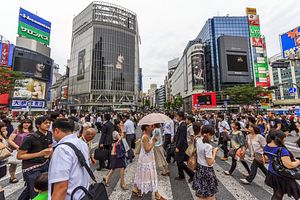The first round of Japanese economic indicators from the third quarter is starting to filter out, with the economy appearing to be muddling through after the initial shock of the April consumption tax increase. Consumer spending in particular has continued to see declines since the increase that will be troubling for the government, as it weighs a decision this December about whether or not to institute a second consumption tax increase to 10 percent in October 2015. These economic figures will inform the debate in the current extraordinary Diet session, where economic policy is set to take a front seat as the administration of Prime Minister Shinzo Abe attempts to reinforce the policies that brought it to power and sustained its popularity.
Before getting into specific economic indicators, the government’s own projections for fiscal 2014 are instructive. The Bank of Japan’s estimate for GDP growth this year is 1.0 percent, however, “informed sources” that spoke with the Jiji Press say the BOJ will revise its Outlook for Economic Activity and Prices report due out by month’s end, saying the new estimate may be anywhere from 0.5 to 0.9 percent.
Consumer inflation was by far the least impressive indicator to come out in the past week. Official data for August released last Friday showed that consumer spending declined for the fifth consecutive month since April. The Ministry of Internal Affairs and Communications said that “average spending by households with two or more members stood at ¥282,124 in August, down 4.7 percent from a year before in price-adjusted real terms.” That decline in August was substantially larger than the August 1997 decline of 0.5 percent, when the last consumption tax increase – from 3 to 5 percent – was instituted in April that year.
Employment data released on Tuesday was better, although not quite positive. The seasonally adjusted unemployment rate declined to 3.5 percent in August, down from 3.8 percent in July, which was the first improvement in three months according to the Ministry of Internal Affairs and Communications. However, part of that improvement was due to people, particularly women, who stopped looking for jobs after failing to find desirable work, according to officials. The tightening labor market is partially what the government is depending on to force companies to increase wages as competition for workers increases, which in turn is expected to drive up prices and thus produce inflation near the government’s 2 percent target. A shortage of workers does appear to be emerging in some sectors, as the restaurant franchise Sukiya will now be closing 1,000 of its locations at night due to a labor shortage. Still, real wages have not kept up with inflation, declining 2.6 percent annually.
Production figures also came out on Tuesday, with industrial production declining 1.5 percent in August compared to July, according to the Ministry of Economy, Trade and Industry, made slightly worse by the fact that economists predicted a 0.3 percent increase. Manufacturing production is expected to increase 6.0 in September but then decline 0.2 percent in October. Goldman Sachs told the Wall Street Journal’s Japan Real Time blog that the “prospects of a production recovery in Japan are diminishing as a result of a decline in corporate Japan’s structural export capacity. In addition, the significant buildup of inventories is likely to prolong the correction in production.”
Inventories in particular are likely to be a drag on production for at least the rest of the year. Japanese firms are reportedly sitting on inventories at five year highs in “excess fuel, plastics and cardboard boxes” as well as “large stocks of unsold items.” Inventories increased 1.0 percent in August for the fourth straight month, with overall levels at their highest since February 2009. Further exacerbating the problem, Japanese companies shipped 1.9 percent less products in August compared to July, despite the 1.5 percent production decline.
The Abe government was likely not taken by surprise by these less than impressive economic figures, which may help to explain why he chose to focus so heavily on the economy during his opening address to the Diet, and leave off pursuing his goals on collective self-defense until next year. If these economic headwinds continue through the fall though, the LDP may be forced to double down on economic stimulus, while seriously considering the possibility of abandoning the next tax increase. If the miracle of Abenomics ultimately starts to flounder, Abe’s ability to implement his security policies will diminish, as they have largely been contingent upon his ability to deliver economic prosperity.
































